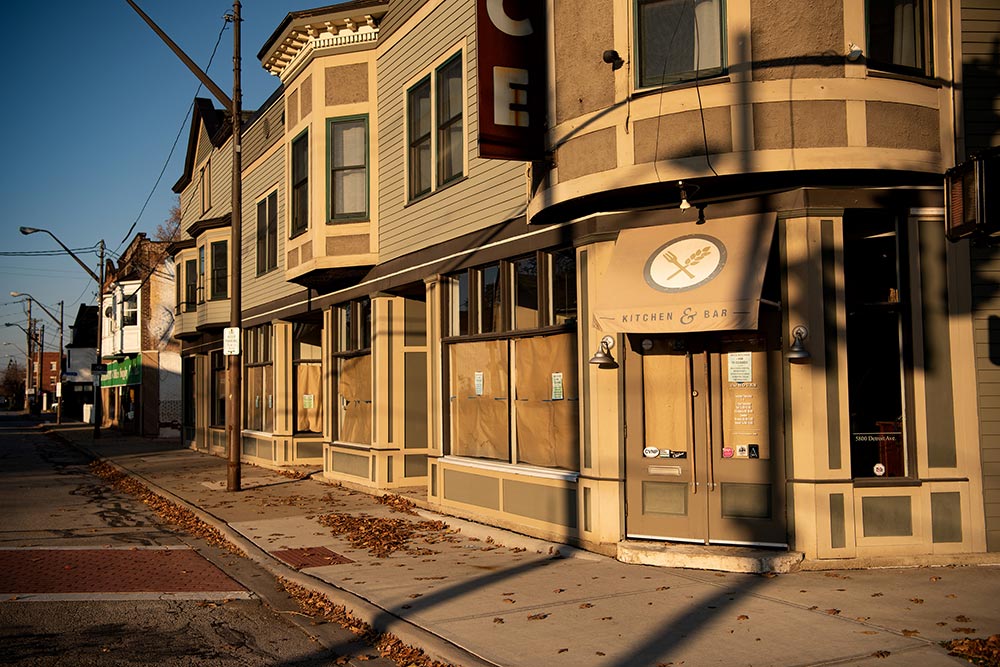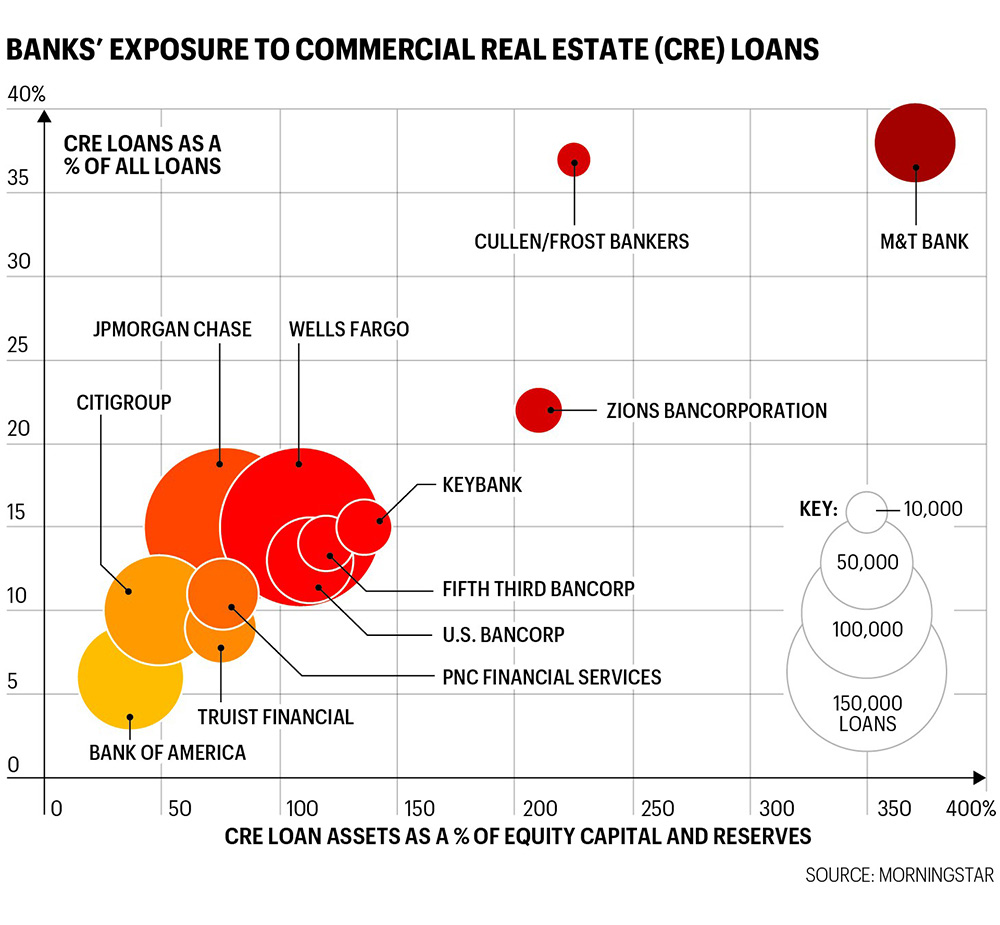
Tattooed Mom酒吧內部從地板到天花板上,都畫滿了涂鴉。這家位于費城南街的酒吧已經有23年歷史,但它卻無法阻止追求時髦的主顧們變得精明起來。雖然有忠實顧客選擇了外賣用餐,但酒吧所面臨的問題是涂鴉難以掩蓋的。酒吧無法盈利,銷售額比疫情之前下滑了70%。羅伯特?佩里表示,他的酒吧會維持下去,但它附近的許多商鋪卻難以為繼。佩里表示:“在一個街區內就已經有六家餐廳倒閉了。你每周都能聽說更多商鋪倒閉的消息,這讓我很傷心。”
一些傳統銀行業者可能很快就會有同樣的感受。疫情導致酒吧、健身房、酒店等商戶生意慘淡,這可能會給商業地產承租人帶來危機,導致數十億美元的貸款出現變數。明尼阿波利斯聯邦儲備銀行行長尼爾?卡什卡利告訴《財富》雜志,商業地產是最脆弱的金融部門,可能會對整個金融體系造成沖擊。卡什卡利表示:“數以千計的小企業已經倒閉……這會波及到商業地產市場,并影響到銀行業。”
中小銀行面臨最大的風險。如下圖所示,據Morningstar統計,在美國銀行和摩根大通,商業地產貸款分別僅占其貸款總額的6%和15%。但在位于大水牛城的M&T銀行和來自德克薩斯的庫倫佛寺銀行,商業地產貸款所占的比例分別高達38%和37%。庫倫佛寺銀行在1月份進行了近20年來的首次裁員。這些銀行都在為貸款違約做準備:2020年,M&T銀行將信貸損失風險計提增加到8億美元,較前一年提高了355%。

任何危機的醞釀時間都可持續數年。除了酒店以外,到目前為止,商業地產并沒有出現異常的低價拋售潮。但房地產私募股權基金Corigin的總裁格雷戈?格利森認為,銀行和業主為了擺脫空置資產,會低價出售更多商業地產。分析公司CoStar預測,到2022年,低價拋售的商業地產價值將達到1,260億美元,到2025年將增加到超過3,200億美元。如果在疫情結束之后,居家辦公趨勢繼續存在,將使辦公樓市場陷入危機,未來商業地產的前景可能更糟糕。《財富》與德勤在12月合作開展的CEO調查顯示,到目前為止,有75%的公司計劃租用更小的辦公室。
但卡什卡利認為,只要銀行提高對貸款組合的警惕,商業地產風險依舊是可控的。他建議關注全國疫苗接種的推進情況:控制病毒需要的時間越長,就會有更多公司停業,銀行所面臨的風險就會越高。(財富中文網)
本文發表于2021年2月/3月的《財富》雜志,文章標題為《疫情導致的商業地產危機或將波及銀行系統》。
翻譯:劉進龍
審校:汪皓
在俄亥俄州克利夫蘭的底特律-肖爾韋,一家被永久關閉的餐廳酒吧。攝影:Dustin Franz —— 彭博社/蓋蒂圖片社
Tattooed Mom酒吧內部從地板到天花板上,都畫滿了涂鴉。這家位于費城南街的酒吧已經有23年歷史,但它卻無法阻止追求時髦的主顧們變得精明起來。雖然有忠實顧客選擇了外賣用餐,但酒吧所面臨的問題是涂鴉難以掩蓋的。酒吧無法盈利,銷售額比疫情之前下滑了70%。羅伯特?佩里表示,他的酒吧會維持下去,但它附近的許多商鋪卻難以為繼。佩里表示:“在一個街區內就已經有六家餐廳倒閉了。你每周都能聽說更多商鋪倒閉的消息,這讓我很傷心。”
一些傳統銀行業者可能很快就會有同樣的感受。疫情導致酒吧、健身房、酒店等商戶生意慘淡,這可能會給商業地產承租人帶來危機,導致數十億美元的貸款出現變數。明尼阿波利斯聯邦儲備銀行行長尼爾?卡什卡利告訴《財富》雜志,商業地產是最脆弱的金融部門,可能會對整個金融體系造成沖擊。卡什卡利表示:“數以千計的小企業已經倒閉……這會波及到商業地產市場,并影響到銀行業。”
中小銀行面臨最大的風險。如下圖所示,據Morningstar統計,在美國銀行和摩根大通,商業地產貸款分別僅占其貸款總額的6%和15%。但在位于大水牛城的M&T銀行和來自德克薩斯的庫倫佛寺銀行,商業地產貸款所占的比例分別高達38%和37%。庫倫佛寺銀行在1月份進行了近20年來的首次裁員。這些銀行都在為貸款違約做準備:2020年,M&T銀行將信貸損失風險計提增加到8億美元,較前一年提高了355%。
任何危機的醞釀時間都可持續數年。除了酒店以外,到目前為止,商業地產并沒有出現異常的低價拋售潮。但房地產私募股權基金Corigin的總裁格雷戈?格利森認為,銀行和業主為了擺脫空置資產,會低價出售更多商業地產。分析公司CoStar預測,到2022年,低價拋售的商業地產價值將達到1,260億美元,到2025年將增加到超過3,200億美元。如果在疫情結束之后,居家辦公趨勢繼續存在,將使辦公樓市場陷入危機,未來商業地產的前景可能更糟糕。《財富》與德勤在12月合作開展的CEO調查顯示,到目前為止,有75%的公司計劃租用更小的辦公室。
但卡什卡利認為,只要銀行提高對貸款組合的警惕,商業地產風險依舊是可控的。他建議關注全國疫苗接種的推進情況:控制病毒需要的時間越長,就會有更多公司停業,銀行所面臨的風險就會越高。(財富中文網)
本文發表于2021年2月/3月的《財富》雜志,文章標題為《疫情導致的商業地產危機或將波及銀行系統》。
翻譯:劉進龍
審校:汪皓
Floor-to-ceiling, the interior of Tattooed Mom is covered in graffiti. The bar, which has been open for 23 years on South Street in Philadelphia, doesn’t stop its hipster patrons from getting crafty. But even with its faithful clientele transitioning to takeout, Tattooed Mom has problems that can’t be painted over. It’s unprofitable, and sales remain down 70% from pre-pandemic levels. Robert Perry says his bar will survive, but many of its neighbors won’t. “Within a one-block radius there are six restaurants that are already gone,” he says. “Every week you read about new closures, and it breaks my heart.”
Some buttoned-down bankers could soon share his pain. As the pandemic wears down bars, gyms, hotels, and other businesses, it runs the risk of causing a commercial real estate (CRE) tenant crisis, which could put billions of dollars’ worth of loans in jeopardy. Neel Kashkari, president of the Federal Reserve Bank of Minneapolis, tells Fortune that CRE is the most vulnerable financial sector—with the potential to cause a shock to the system. “Thousands of small businesses have already or will go under?…?That rolls up into the commercial real estate market and rolls up into the banking sector,” Kashkari says.
Small to midsize banks face the greatest risk. At Bank of America and JPMorgan Chase, CRE makes up only 6% and 15% of all loans, respectively, according to Morningstar. But that figure is 38% at Buffalo-based M&T Bank and 37% at Texas’s Cullen/Frost Bankers—which in January conducted its first layoffs in nearly two decades. Banks like these are bracing for defaults: In 2020, M&T increased its provision for credit losses to $800 million, up 355% from the prior year.
Any crisis could take years to brew. Outside of hotels, distressed sales of commercial property aren’t abnormally high to date. But Greg Gleason, president of real estate private equity firm Corigin, says more such sales loom, as banks and owners unload vacant assets. Through 2022, analytics firm CoStar forecasts $126 billion in distressed CRE sales, with the total rising to over $320 billion by 2025. The outlook could be grimmer if work-from-home trends outlast the pandemic, creating trouble for office buildings. As of now, 75% of companies plan to use less office space in the future, according to a Fortune survey of CEOs in December in collaboration with Deloitte.
Still, Kashkari says the CRE risks should be manageable if banks are vigilant about their portfolios. Keep an eye on the vaccine rollout, he advises: The longer it takes to tame the virus, the more businesses will close—and the shakier some banks will look.
This article appears in the February/March 2021 issue of Fortune with the headline, "First bars, then banks?"






